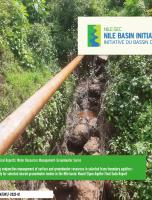Abstract
The Nile Basin is thought to be sensitive to climate change and prone to climate-induced water scarcity
(Eckstein 2009). Higher temperatures will increase evaporation rates from existing and new reservoirs,
leaving less water available in storage for agricultural, industrial and municipal use. An increase of
3° C (corresponding to what most models forecast for the next 50–100 years) will increase crop water
requirements for the existing crop mix in the basin by approximately 10 % (Jeuland 2009). Increased
evaporation, crop water use and household water use will tighten the balance of water supply and demand
throughout the Nile Basin (Whittington et al. 2014) coinciding with an increasing uncertainty in precipitation
and, hence, surface water availability. Furthermore, the Nile Delta is at risk due to sea level rise because of
climate change, which would entail catastrophic loss of agricultural land and require massive population
resettlement or considerable investment in protective infrastructure (Whittington et al. 2014).
This mismatch between supply and demand may require technological solutions such as increased
groundwater use (which was not considered in this study), augmenting supply through increased rainwater
harvesting and conservation, improve water retention properties of soil in the upstream countries, and
improve productivity and water-use efficiency in both upstream and downstream countries. While actions
are taken to meet the water demand; pollution control measures are equally important as surface and groundwater pollution, soil erosion, and salinity development, are severe in the basin (NBI 2012). Water access, demand, usage and management is complex due to its transboundary nature in the basin (Choudhury and Islam 2015; Paisley and Henshaw 2013), requiring collective water management action. Escalation of tensions between the upstream and downstream riparian countries (Whittington et al. 2014) are common; although there are trends talking more on multilateral cooperation, equity and sustainability, resulting cooperation among riparian countries in sharing transboundary water (Choudhury and Islam 2015). Some authors talk about the Grand Renaissance Dam (GERD) as being catalyst of change (Cascão and Nicol 2016), triggering further cooperative management of the basin. Cooperation in the Nile Basin will be important to meet future water demand and share water related scarcity risks among riparian countries (Blackmore and Whittington 2008).In the NB countries water is considered a free resource (El-Gafy and El-Ganzor 2012). Water pricing, whether by administrative mandate or by market forces, is an important way to improve water allocations




